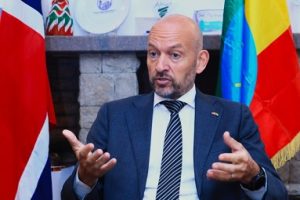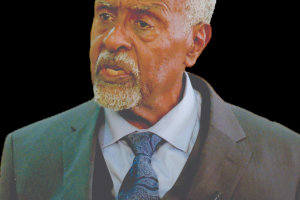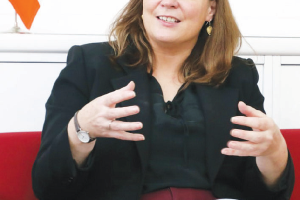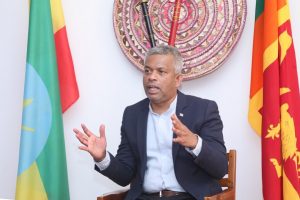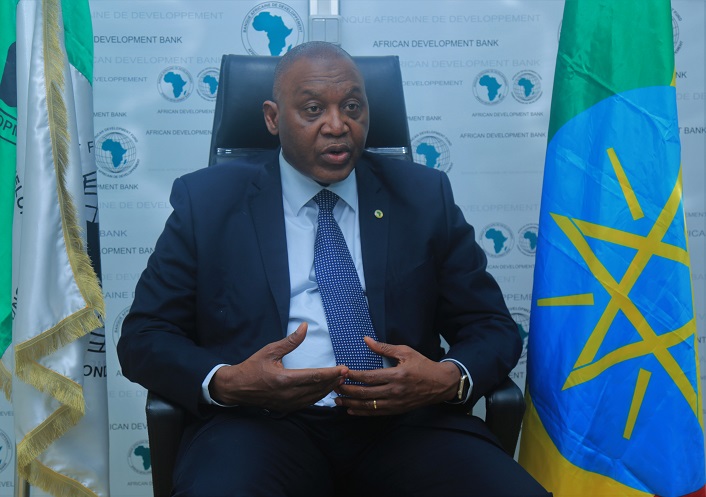
BY GIRMACHEW GASHAW
Herald Guest for today is Abdul Kamara (PhD), the Deputy Director General of the African Development Bank for the East African region. Based here in Ethiopia, he is also the country manager as well as in charge of the African Union and the ECA in collaboration with the African Development Bank.
The AfDB was founded following an agreement signed by member states in 1963, in Khartoum, Sudan, which became effective on September in 1964. The AfDB comprises three key institutions: the African Development Bank (AfDB), the African Development Fund (ADF) and the Nigeria Trust Fund (NTF). Since its creation, the Bank has actually grown and transformed significantly both in terms of relevance and financial strength, and has now become Africa’s premier development financial institution, proudly enjoying triple-A (or AAA) rating by all major global rating agencies. Ethiopia is proud to count among founding member of the Bank Group.
In the early 1960s, newly independent African countries wanted to take their continent’s development destiny in this own hands. And to do that they primarily had to strengthen their financial muscle. So this is how the African Development Bank Group was founded by up to 22 African countries which signed that instrument of ratification, and then raised about 65% of the initial capital to start the Bank that is today a more than $200 billion dollars-strong global institution.
The Ethiopian Herald has recently interviewed Kamara on these and other diverse African development issues. Have a nice read!
Could you tell us where and how AfDB mobilizes its resources?
Firstly, the African Development Bank Group (AfDB) Bank comprises three mutually reinforcing institutions: the African Development Bank (ADB), the African Development Fund (ADF) and the Nigeria Trust Fund (NTF). The ADB is financed by its shareholders, which is, payments from shares and subscriptions, accumulated equity over the years and returns from Bank’s own investments. So, today, as I speak, the Bank Group’s non-concessional institution (ADB) has an authorized capital of over US$200 billion. This follows 103% replenishment in 2020 which raised Bank’s authorized capital from $93 billion to the level that I just mentioned. The ADB arm entails the non-concessional resources which we use to lend money to credit worthy middle income economies, such as Egypt, South Africa, Nigeria, Botswana, among others, and some low income economies with a capacity to borrow and repay at rates slightly below market, but also targeted to really accelerate the economic transformation of African countries. The ABD also extends loans and guarantees to credible private sector entities whose work complements the Bank’s mission and contributes to accelerating the continent’s development.
The African Development Fund (ADF) is the concessional window which is replenished every three years, and raises resources that low-income countries can access as grants and interest-free loans with long maturity periods. ADF resources are accessible to low-income economies in loans and grants, and sometimes extended as grant-only to relatively poorer countries, or countries in special circumstances. The NTF resources are extended to countries with a special focus on technical assistance, capacity building, strengthen governance and finance up steam origination work that leads to the preparation of transformative operations that can be financed from the other two windows.
For Ethiopia for instance, since we started operations in early 1980s, we have financed projects and programs worth about 6 billion USD in loans and grants, mostly in infrastructure including road transport, energy, water and sanitation, and in agriculture and economic governance and social sectors including health and education.
And currently, as I said earlier, we have an active portfolio of US$1.6 billion in key sectors including transport, energy, water and sanitation and now we are moving slowly to accompany the country’s agricultural transformation where investing in the integrated agro-industrial parks, we currently have close to 100 million USD in key operations all in grants.
Would you tell us the lending capacity of the Bank? Does the Bank have healthier relations with African countries?
Definitely we do. The African countries are all members of the Bank, so they own the institution along with the 27 non-Africa countries, which we also call non-regional member countries.
So yes, we have an excellent relationship with African countries, demonstrated by our strong focus and alignment of our operations and services to country needs, through our ‘High Fives’ priority areas seeking to accelerate the economic transformation and development of African countries. In the case of Ethiopia, for instance, this was recently demonstrated by the Honorary Doctorate Degree that the Ethiopian Prime Minister awarded to the Bank’s President, when the Prime Minister exclusively indicated that this was a unique gesture was in appreciation of the Bank’s contribution to accelerating Ethiopia’s development. But beyond our contribution to this country, the Bank also belongs to Ethiopia as Ethiopia is one of its shareholders. The Ministers of Finance of the members countries, including all African ministers of finance, are the Governors of the Bank Group. If you take Ethiopia, for example, Minister Ahmed Shide is a Governor African Development Bank Group, and is part of governing body that make decisions on the strategic directions and orientation of the Bank. We also have a board of Executive Directors, where each country is represented on a day-to-day basis. So, through these various levels of interactions, we are having a very close relationship with the countries.
And what is even more important here is that the African Development Bank Group always tries to align its projects and programs with country priorities and needs. For example, for Ethiopia, our engagement over the past 5-6 years, has been strongly aligned to GTP I and II, which were succeeded by the Homegrown Economic Reform Program, and now the Ten Year Perspective Plan. Indeed, the core part of our work also entails providing advisory services and knowledge work that informs planning and decision-making in African countries
indicated earlier, the Bank’s work is guided by its High Five strategic priorities, or the ‘High Fives’, which primarily focuses on availing energy to the continent, feed Africa integrating the continent, industrializing the continent and improving the quality of life for the people of Africa.
So our active engagement in the country’s key sectors of energy, transport, industrialization and integration are strongly linked to the country’s own priorities and the High Fives. That’s why, for instance, we are also accompanying countries like Ethiopia currently in its industrialization through our financing of the integrated agro-industrial parks, as part of a broader flagship program that we call special agro-industrial processing zones (SAPZ).
Because countries are at different stages of development and transformation, our focus areas and priorities differ from country to country. Therefore work in each country is guided by our Country Strategy Paper, a five year document that enables us to agree on key priorities with the country. Ethiopia for instance, we are currently developing the Ethiopia country strategy 2023 to 2027. It will prioritize what we are going to do. We will have a midterm review after two years to create an opportunity for adjustments depending on the prevailing situation.
What are the major challenges that the Bank has faced so far?
I think the key challenge here is that the continent’s needs are diverse in a scenario where resources are never enough. So, you have to manage it in a way that you maximize efficiency and effectiveness, so that you get the most impactful development outcomes from the use of these scarce resources.
But the second area of challenge also relates to some of the things that we are observing on the continent. If reflect over the past decades, you will see that conflicts have virtually refused to go away or they are doing so at a very slow pace. In fact, while prevailing conflicts subside, as we see in Sudan, Mali, Mozambique and now Ethiopia. So, these are significant challenges, because, whenever these happen, you will have to adjust your portfolio and your new programming to ensure countries get the best and most appropriate support based on prevailing situations; that is you have to ensure that you provide support that will, first of all, give stability to these areas.
I think the third area of challenge is the global dynamics or global shocks. We have just been grappling with the COVID-19 pandemic, and we had to adjust our support all countries to this challenge. This is not something that is in Ethiopia’s country strategy that I was talking about, but we had to immediately respond to it by repurposing or resources to provide US$ 120 million grant to Ethiopia to fight the pandemic. And just before COVID, we know that Ethiopia had been grappling with desert locust invasion and now droughts, not only in Ethiopia but in neighbouring countries as well.
We are currently working on programs to help African countries adjust to the global challenge of climate change. So, these are some of the challenges, but I can really assure you that we are very much on top of things, and we are doing what it takes to help African countries stand up to these challenges. For example, now we are looking the food crisis resulting from the Russia invasion of Ukraine, which has seen wheat prices rise significantly and supply chains disrupted or threatened. And we know that, several countries, including Ethiopia, have relied on these two countries over 60 per cent of their wheat imports.
So, recently, our Board a framework for an African Emergency Food Crisis Response Facility, which will allow us to repurpose about US$ 1.5 billion, go ensure that we address the structural issues that will help countries to adapt to this looming food crisis, because we do not believe that this is a temporary situation. Firstly, you do not know how long that conflict is going to last. Secondly, even if it does conclude in a few years, how sure are we that all those supply chains will be revitalized overnight. So, we want to boost the production capacity of the continent primarily through access to fertilizers, but also through targeted support to existing agricultural production initiatives in these countries.
What is the benefit of having non-regional numbers?
This is a very important question. When the bank was established in 1963, or 64 and started operations, it was all Africans. But development is a very complex phenomenon. In development, we always say, ‘No one can do development better than all of us together’. As such, the presence of non-regional’s in the Bank is a great partnership that has mutual benefits, given the common objective to advance the development of African countries. This is how non-regional members came to be part of the Bank.
And as you can see, the Bank has been to move from a low capital base at its creation to an impressive $ 200 billion authorized capital that we see today. But of course, the Bank maintains its African character. The Bank’s headquarters will always be domiciled in Africa, in Abidjan, Ivory Coast, and the President of the Bank will always be an Africa.
What type of projects does the Bank finance?
We have our Ten Year Strategy 2013-2022, which will soon be succeeded by our long term strategy currently being developed, which will continue to focus on our ‘High Fives’ priorities. It is these long-term strategies and the High Fives that broadly define the context in which the African Development Bank develops its products and programs.
So, in the context of what we finance, anything that falls within the ‘High Fives’ priorities is eligible for financing by the Bank. So, across Africa, we finance agriculture, energy, finance, transport, health, education, water and sanitation, governance (especially financial and economic governance) and Cross Cutting issues including gender and climate change.
Of course we also finance the private sector, as said earlier whose work and services align or contribute to the Bank’s mission. In Ethiopia for instance, we have financed Ethiopian Airlines twice to support its fleet expansion and cement company called Derba Midroc Cement, which in 2017 brought down the price in Ethiopia by 75% through boosting local production. So those are the kinds of programs that we support for Ethiopia very explicitly, because it is important. To give some example, again using Ethiopia, in the 5-7 years we have approved projects and programs worth about US$ 2 billion in different loans and grants. These include operations like the Mombasa-Nairobi-Addis Highway, with important components in the two countries and one-stop border post at Moyale to facilitate trade. this road was officially launched by the Prime Minister of Ethiopia and the President of Kenya in 2020We also have transformative operations like the Ethiopia-Kenya Electricity Highway, which is an operation that we are co-financing with the World Bank and Agence France de Developpment. This operation is important in connecting Ethiopia to the East African Power Pool and in helping the country export power and earn foreign exchange.
Does the Bank support the mega development projects focused on reducing poverty across Africa?
We do. I think in the context of here in East Africa, I have already indicated some of them. For Ethiopia we have discussed some of them but I will give you more exampled, including the ‘Addis Ababa Transmission and Distribution Rehabilitation and Upgrade Project’, financed with US$200 million by the Bank and the Japanese development agency JICA. Our contribution was about US$100 million and this will go a long way in increasing connectivity, but for poor peri-urban community and businesses, and thereby help create jobs reduce poverty We just spoke of our support to the integrated agro-industrial parks, which seek create jobs in agricultural value addition and this reduce Poverty. The list of our interventions is long but let me just add that we also have the ‘Drought Resilience and Sustainable Livelihoods Programs’, focusing relatively poorer communities in Afar, Somali, SNNPR and Oromia regions.
Thank you for your time
You are welcome
The Ethiopian Herald 25 June 2022

